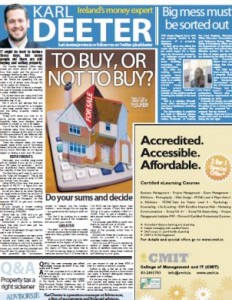 Irrespective of what you may read or hear, there are property transactions occurring. According to the CSO the price drops are about 40% from peak. The amount of mortgage lending may is down 90%, if you are a Rothschild at heart then the adage ‘when there is blood on the streets, buy land’ is ringing in your ears.
Irrespective of what you may read or hear, there are property transactions occurring. According to the CSO the price drops are about 40% from peak. The amount of mortgage lending may is down 90%, if you are a Rothschild at heart then the adage ‘when there is blood on the streets, buy land’ is ringing in your ears.
For the first time in about a decade we are seeing the actual costs in property make sense. Today we are going to show you how to do some simple comparisons so that you can do this for yourself.
We’ll need a few constants; first of all will be the interest rate – even though rates are subject to change at the drop of a hat. National Irish Bank offer a 10yr fixed rate at 5.5% and we’ll use that as our benchmark.
You can get much cheaper rates by going variable depending on your loan to value (for instance AIB have a 3.09% rate if your loan is less than 50% of the value of your home), but we’ll just take a good long term fixed rate for this demonstration.
We’ll also do our figures based on taking a loan over 25 years, you can get cheaper monthly repayments by going for longer terms, and in our brokerage experience that is precisely what the majority of first time buyers do; but at the same time, it can skew figures in favour of borrowing which is something we don’t want.
The ‘cost per thousand’ is the actual cost per month for every €1,000 borrowed over 25 years, using that 5.5% rate above it gives us a figure of €6.14. So all you have to do when figuring out repayments is divide the price by 1000 and multiply by the ‘cost per thousand’ of 6.14 to get your monthly repayments
A house costing €200,000 with a 90% mortgage (€180,000) will cost 180 x 6.14 = €1,105 per month. You can then compare this to the rental price. If you are a first time buyer in 2011 you will also get Tax Relief at Source.
So to see if the cost of renting or buying is to your liking then use the method above. There are more comprehensive comparisons we use in the office but this is a simple rule of thumb.
The other comparison method we will use is the ‘investor method of valuations’. This is a simple sum that that people who are buying to rent a property out would (or should!) use.
You do it by looking for a certain ‘yield’ or return, generally it should be about twice that of deposit rates – because you are taking a risk – and it should also be 50% greater than borrowing rates, you take whichever is the higher of the two.
Good deposit rates at present are in the region of 3.6% and borrowing rates on investment loans are c .5%, meaning we will use the higher of 3.6% x 2 (twice deposit rates) or 5% x 1.5 (this gives you 50% higher than the 5% investment rate), meaning we will do our sums looking for a 7.5% return.
The way to do the investment method is to take your yield number (7.5%) and divide 100 by it to get a multiplier (100/7.5 = 13.33) then to get a valuation you take annual rental value and multiply it by 13.33.
So if a property gets €650 a month rent then its 650×12 to get annual rent (€7,800) then multiply that by 13.33 (to get the value of the property) €103,974.
This valuation can be used even if you are buying a home because you could use the rent it might receive if you let it out as a way to gauge the value even though you want to live there.
This method is highly unpopular in Ireland, we generally use ‘comparison prices’, but having the ‘investor method’ to hand is a great tool when trying to sniff out deals.
Armed with these two tools you can decide for yourself whether or not a property purchase makes sense or not, it can help you in your negotiations and make sure you don’t over pay if you are thinking of buying.
And don’t be put off if you are rejected by sellers or estate agents, we have plenty of satisfied customers who can tell you that it is worth it to use these methods and stick to your guns!

Post a Comment